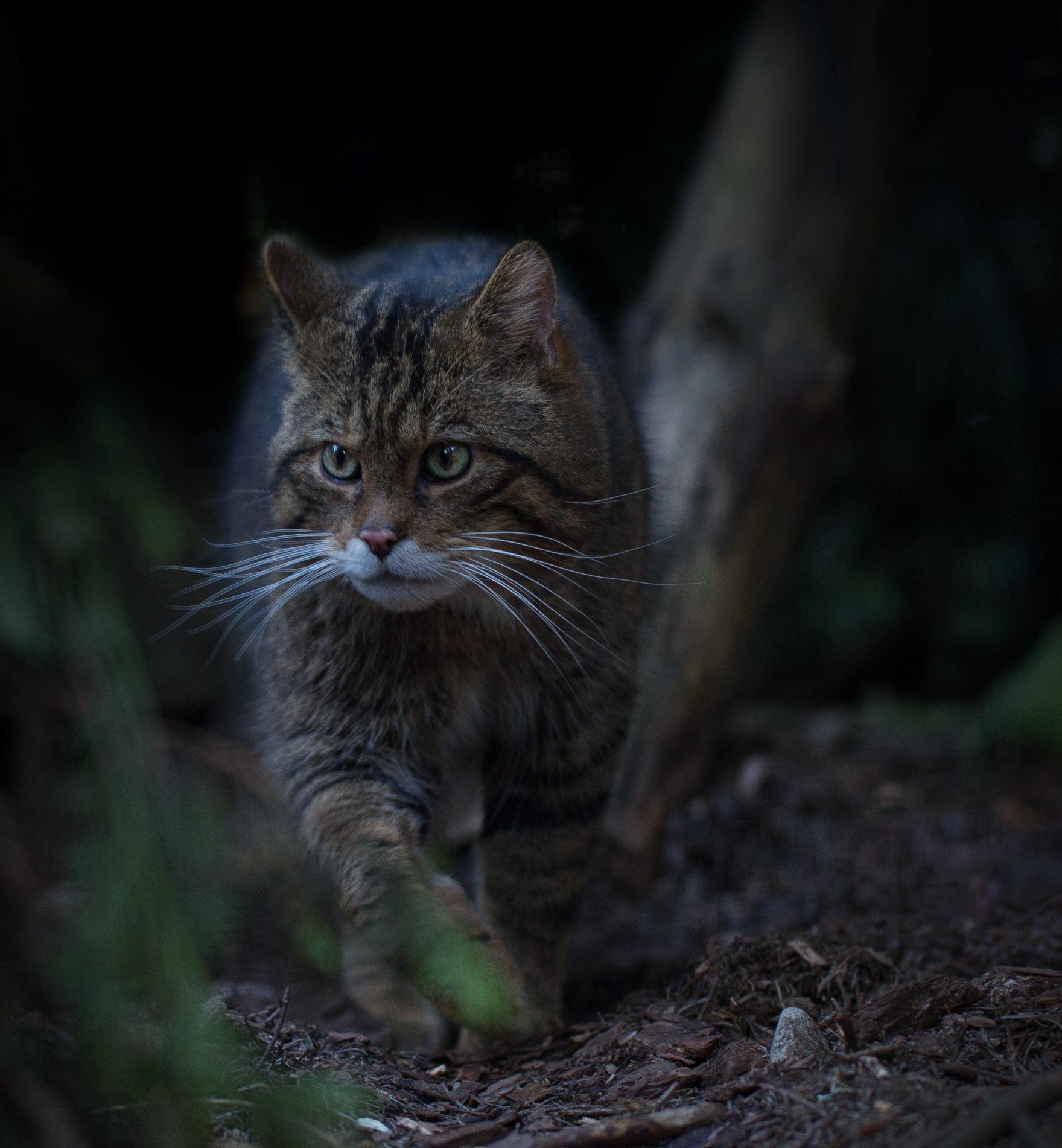
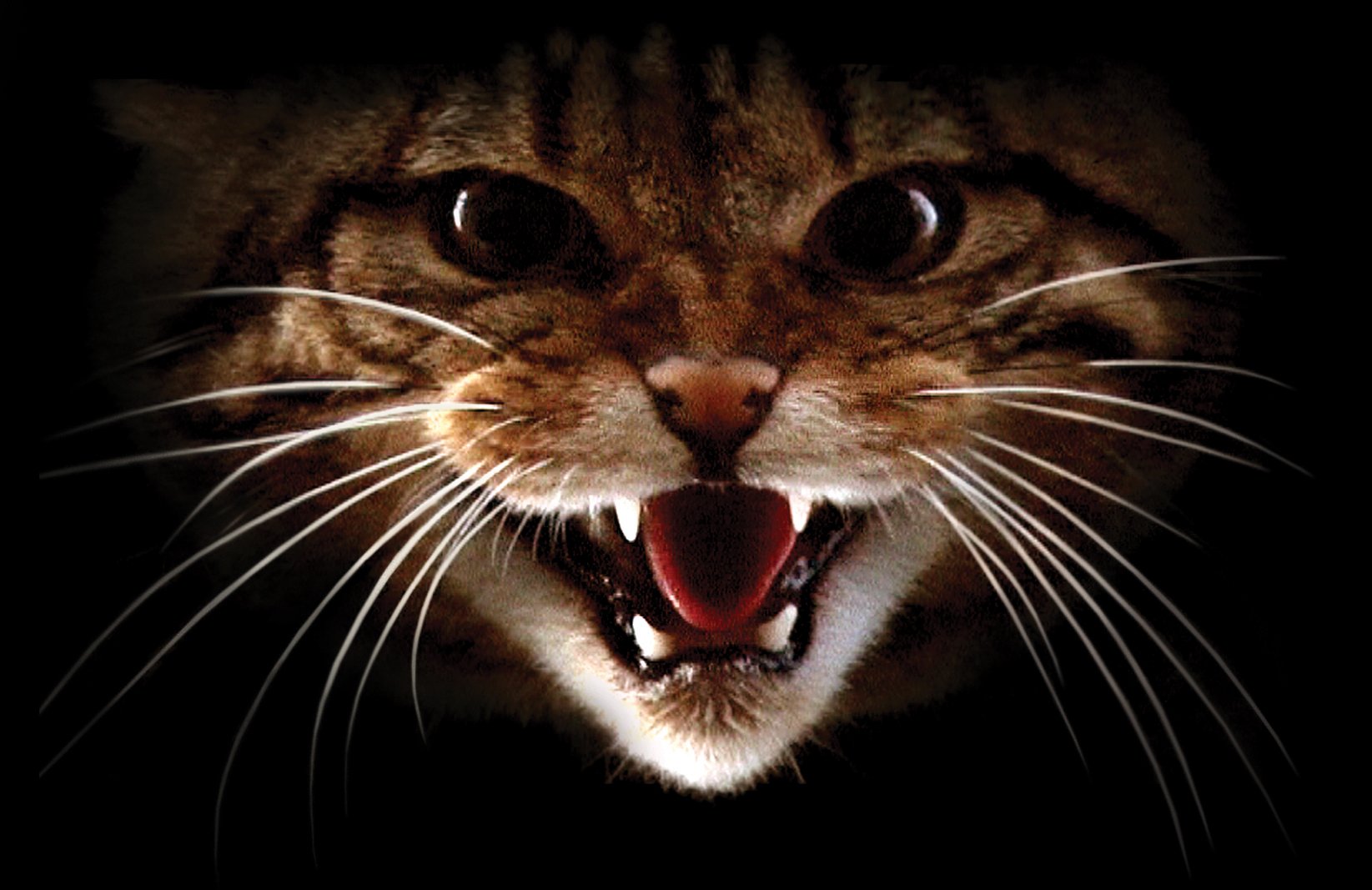
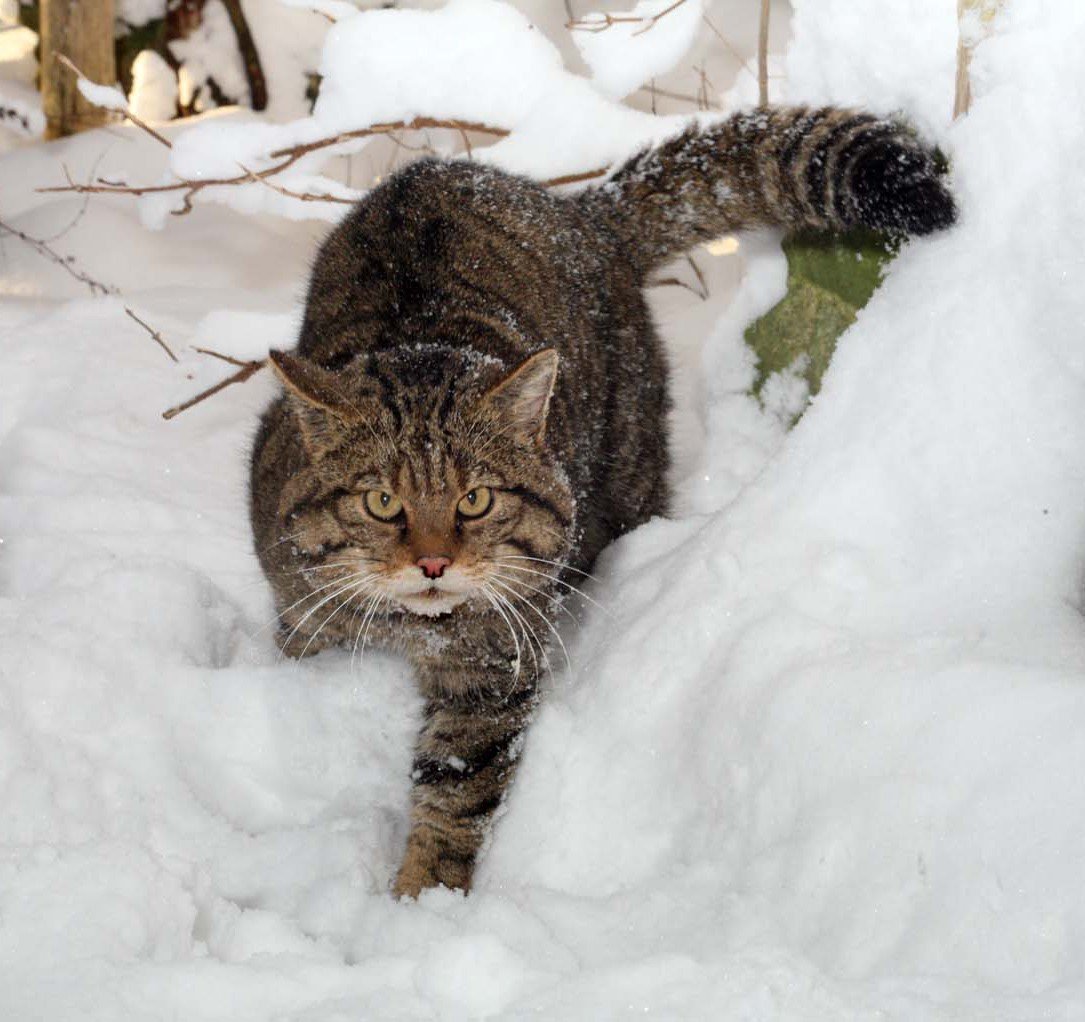
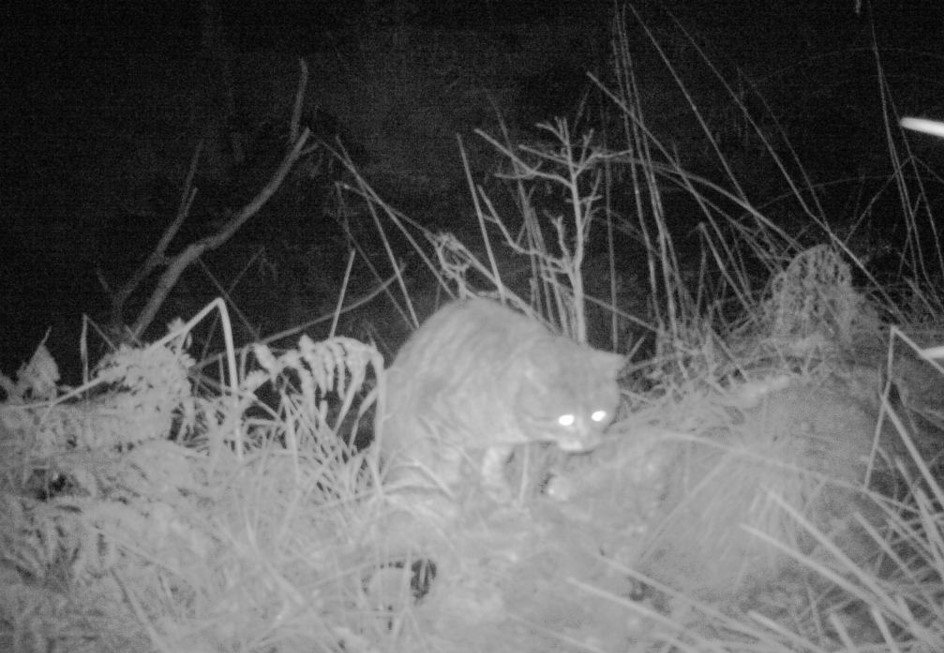
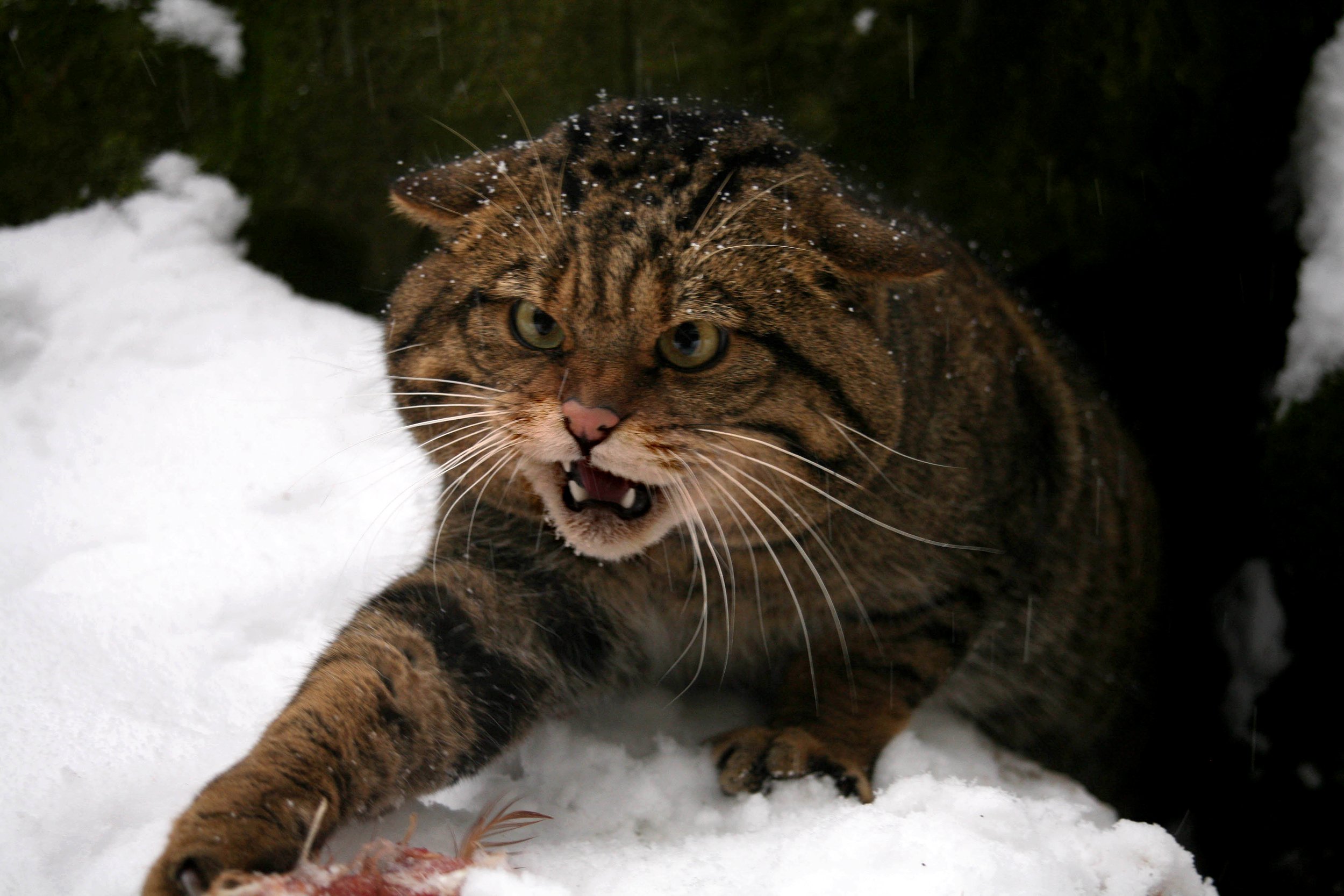
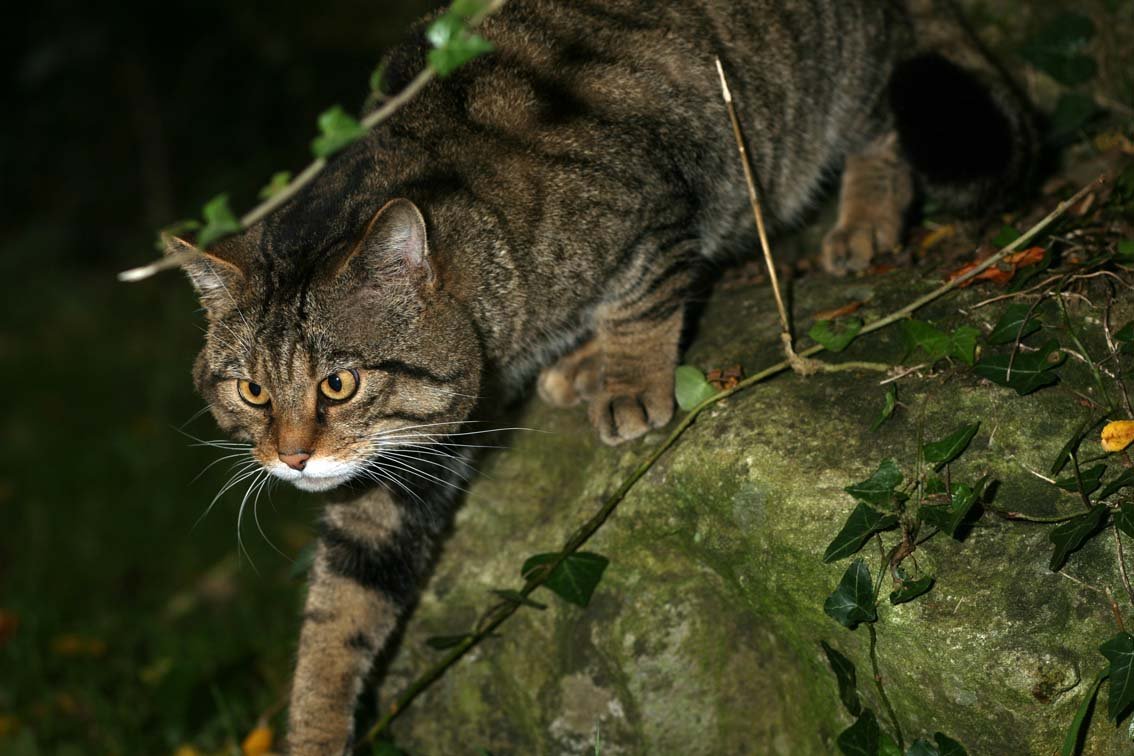
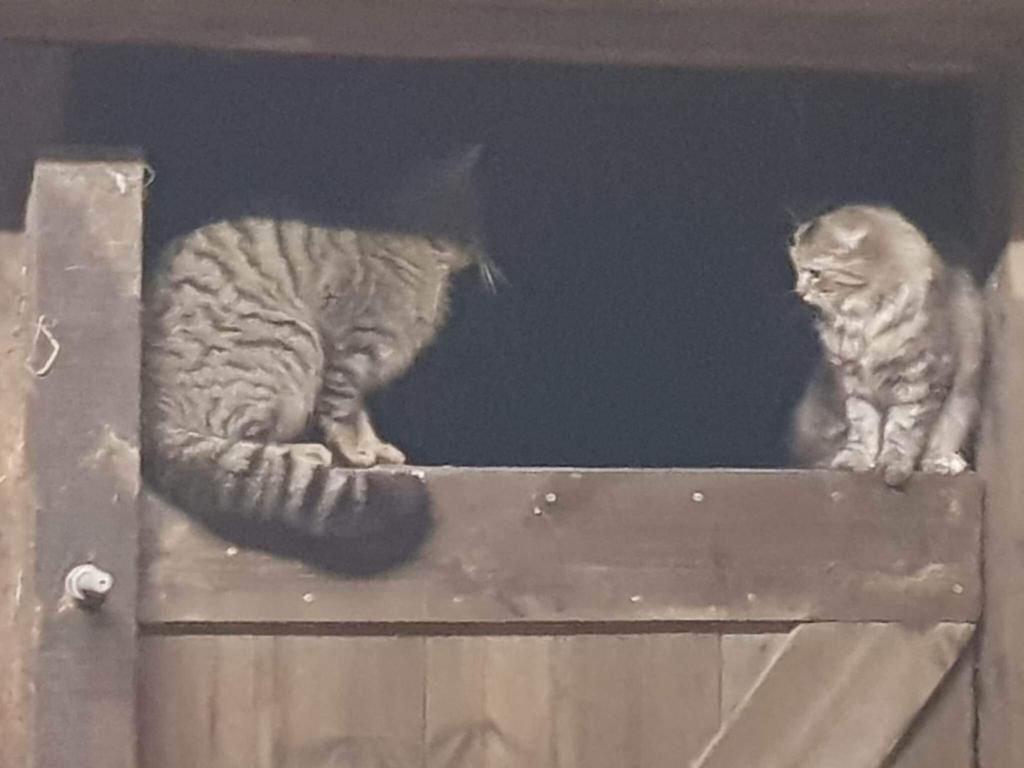
About the Scottish Wildcat
-
The Scottish wildcat evolved from a population of European wildcats which became isolated by the English Channel over 9000 years ago. They are the largest of the wildcat family and can be double the size of a domestic pet cat and infinitely more ferocious.
The fur of the Scottish wildcat is a great deal thicker than that of a domestic cat.
It displays very distinctive solid black and brown stripes. Spots, broken stripes or white fur are all indications of hybridisation (cross-mating) with domestic cats.
Another notable feature is their thick banded tail, perfectly ringed with no dorsal stripe running off of the spine. Imperfect rings or dorsal markings are further signs of hybridisation.
Like all cats they have superb hearing, retractable claws, exceptional night vision and a powerful body conducive to sprinting and pouncing.
Scottish wildcats epitomise the solitary, independent super-predator and the mysterious and wild spirit of the Highlands in a way that no other animal can.
-
This is very difficult to answer. The size of a Scottish wildcat is another thing that has been confused by hybridisation.
Most sources state that wildcats are up to 50% larger than a domestic cat. Given that domestic cats vary in size a great deal, this description is of limited value.
It adds further difficulty to the answer when you consider that these observations have been made by people observing hybrids which were mistaken as wildcats. These hybrids were observed in captivity, or were actually European wildcats.
European wildcats have been consistently described as slightly smaller animal. This makes sense, as they live in warmer climates and would have less need for body mass such as fat to keep warm).
Recorded history
Thankfully, there is some useful information in the history books. Victorians dug up a wildcat skeleton that measured 4 feet from nose to tail tip. The following statement appears in A General History of Quadrupeds by Thomas Bewick in 1790;
“Some Wild Cats have been taken in this kingdom of a most enormous size. We recollect one having been killed in the county of Cumberland, which measured, from nose to the end of its tail, upwards of five feet”
It seems likely that the true wildcat is a far more substantial animal than we’ve given it credit for over the years. One eye witness sighting collected by the SWA in 2008 reinforces this idea.
eye witness reports
The eye witness reported that a German shepherd dog chased and cornered a wildcat only for the cat to launch a retaliatory attack. The unfortunate dog didn’t do all that well, getting a considerable quantity of it’s face torn off and a hefty vet bill.
The dog owner insisted the wildcat’s paws were virtually the same size as the dog’s and that the cat itself was far larger than they expected a wildcat to be. The description of markings, banded tail etc. made it clear it couldn’t be one of the UK’s famed “alien big cats”.
So one of the simplest questions about wildcats has one of the most difficult answers.
It seems quite possible that the wildcat we’re trying to save will be something closer to 100% larger than a domestic or more. A cat of that size would be consistent with the Highland legends of them bringing down small deer.
-
Wildcats live until around 7 years of age in the wild, and up to 15 years old in captivity. Predators such as eagles and foxes are a threat to unguarded kittens but will avoid confrontations with adult cats.
In the wild, a wildcat may sustain injuries which prevent it from hunting. Humans cause injury and death via shooting, snaring and road kills. There are no reliable statistics on the most common causes of death.
-
Aggression
Thought to be man-killers as recently as the 1950s, they are ferociously aggressive defending themselves or their young.
Like much bigger cats, they may even even mock-charge at larger threats, but in reality they deeply fearful of mankind and will do anything they can to avoid us.
Adaptable Hunters
Unlike most cats, the Scottish wildcat are multi-habitat hunters. This behaviour has evolved in response to the severe deforestation that has taken place across the British Isles. This particular behaviour distinguishes the Scottish Wildcat from the mainland European population of wildcats, which tend to be forest specialists.
Less Fearful Of Water
Scottish wildcats fear water less than other cats, which is lucky since they live in Scotland!
Their thick coat keeps out rain, and the capability to prowl along riverbanks provides a great deal of hunting opportunities. The Scottish wildcat will fearlessly swim across a river in order to explore the opposite side.
Solitary
They live solitary lives in the most remote corners of the Scottish West Highlands. The wildcat is active mostly at dawn and dusk (making them a crepuscular species) hunting or maintaining territorial scent markings.
Territories can be as small as 1-2 square miles up to 40 square miles depending on the density of their prey. A typical territory will include a variety of habitats.
Whilst solitary most of the time, the territories of male and female Scottish wildcats will overlap occasionally during mating season.
Cats mark their territory with feline scent markings such as spraying, faeces, clawing and face-rubbing on tree trunks and fenceposts around their territory.
Other cats can interpret these scents to understand the sex, age and health of the other cat, indicating its value as a potential mate or threat as a competitor.
Quiet
Vocal communication is extremely rare in Scottish wildcats. Hissing and yowling are saved for displays of aggression. Wailing is preserved for when female cats are looking for attention from a neighbouring male. Even kittens play in complete silence so as not to attract the attention of predators.
Wildcats have lived in the UK for at least two million years. They have been forced out occasionally by ice age glaciation, and have survived dramatic changes to their habitat over the last hundred years.
-
Scottish wildcats are obligate carnivores surviving almost exclusively on meat. They play an important ecological role in controlling the numbers of small to medium sized prey animals such as rabbits, rats, hares and other small animals.
Whilst they will opportunistically prey on birds, insects, lizards and even sometimes fish, these species make up a fraction of their diet.
They follow typical feline hunting approaches: slowly creeping close to their prey for a pounce-chase-catch-kill. They will also utilise knowledge of their territory to carry out ambush attacks.
Their killing method is quick and clean with a bite to the throat or spinal cord at the neck.
The Scottish wildcat is often blamed for killing agricultural and game species such as game birds and lambs.
However, records of Scottish wildcat kills (prior to legal protection was afforded) suggest hybrids were the primary culprit.
As per most cats, in desperate times they can and will eat carrion and it is possible that sightings of them feeding on dead deer or sheep may have led to legends of them hunting such large species.
-
As with most casts, the Scottish wildcat has finely honed senses.
Vision
The wildcat is able to see incredibly well at night. During the day, the wildcat sees only partially in colour, and their eyes are highly adept at spotting movement rather than detail. This is true even of their peripheral vision.
Hearing
Their hearing can precisely triangulate the source of any sound, which allows them to hunt productively in dense cover. They can also detect and differentiate between a wide range of tones far in excess of canine ability.
Taste
As carnivores, their taste is developed for eating meat. They have little ability to detect sweet flavours.
Touch
Their touch sense is highly acute, and their paws are able to detect minute ground vibrations.
Whiskers and other specialised hairs are able to detect minute changes in air current.
The Scottish wildcat is very agile and has a highly developed balancing system.
Smell
Their smell is less developed than in canines, but still sufficient to detect prey and carrion. Smell is also used as part of communication with other wildcats which leave scent markings around territorial edges.
-
During mating season, female wildcats will heavily scent patches of territory which overlap with a male cat’s territory. They will also wail loudly at night to advertise readiness for mating during mid-winter.
Male/female pairs briefly socialise between January and March purely for breeding purposes, with an average of three kittens born between April and May that are then brought up by the solitary female.
Scottish wildcats only breed at this time of year so that their kittens can sufficiently grow to survive the harsh winter.
If a female loses her litter, she may seek to have a second litter in late spring or early summer.
Wildcats do not form classic “breeding pairs” and so far as we know males have no involvement with their young at all.
-
Kittens feed on their mother’s milk before quickly progressing to eating meat which is brought to them. Kittens then learn to hunt on live prey brought to them before progressing to true wild hunting.
After a spring, summer and autumn growing and learning to hunt and survive they become independent moving into their first winter and sexual maturity, but typically will not mate until their second year.
Closely related to domestic cats they are able to produce offspring with them, called hybrids. Noted for centuries this process appears to have become the primary threat alongside deforestation as the ratio of Scottish wildcats to domestic ferals has plummeted and it has become increasingly difficult for wildcats to find other wildcats to mate with.
The current ratio has been estimated at anything from 100:1 to almost 3000:1.
Some hybrids have a very distinctive form being pure black, very large but slim and lithe like a domestic cat, these are known as Kellas cats: they are not a new species but a specific mixture of wildcat/domestic genes.
A melanistic wildcat has been recorded on one occasion (the same process that creates all black leopards or jaguars).
